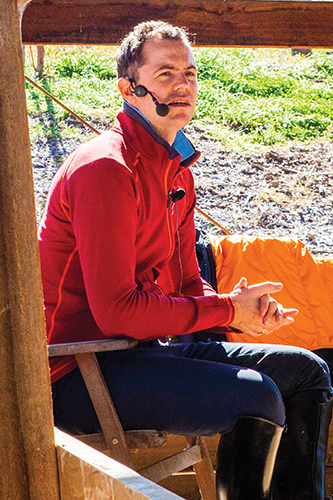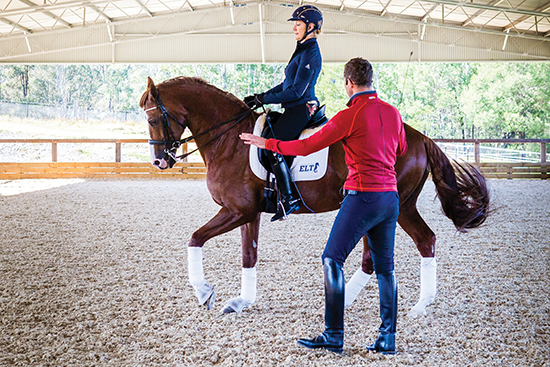 Rebecca Ashton wrote the words and took the photos
Rebecca Ashton wrote the words and took the photos
So often Australia is in a froth of excited exuberance. A new international trainer is coming to spread his knowledge over three days. Clinics are full to the brim with waiting lists the length of my Christmas wish list and then after one or two visits, everyone loses interest in the ‘flavour of the month’ and goes back to their daily grind. Stefan Wolff has been coming down south to train Australian dressage riders for over ten years now. Not only are his clinics still full, riders continue to rave about him. His classical approach and sympathetic way of delivering his message fill riders with confidence and give them new tools that work, and that they can understand.
I sat in on a clinic organised by Dianne White and held at Lesley-Anne Taylor’s glorious property just west of Sydney. Lesley’s 11-year-old import, Amicelli Gold is known for his ebullience. Lesley has done a great job getting him to Grand Prix and it’s now time to improve the quality of the work. The session started with relaxed stretchy work but Stefan wanted more, “Even longer neck. It’s always more than you think when you sit on him. When you think you’ve reached the maximum, there is still 5cm more. Even more forward. Don’t sit heavier in the half halt, just sit in the movement. The best driving aid is sitting in the motion.”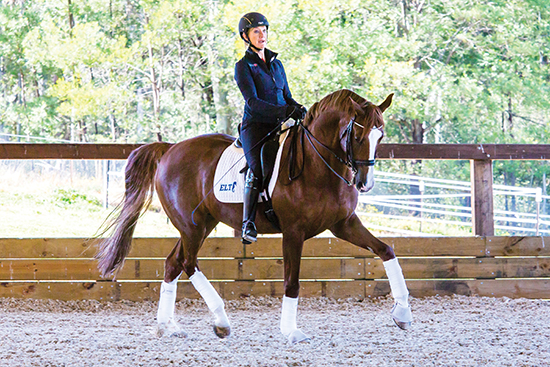
“Now some figure of eights. Get him to lengthen the outside of the body in all the bends. The inside of the body just travels straight on. That guarantees that he is in front of you. If you shorten the inside, it is harder to get them in front of you.”
The German continued his insistence of keeping the horse in front of the leg at all times and not letting him drop into the inside shoulder as Lesley took the horse into shoulder-in and half pass work. The thing with Stefan, he doesn’t just tell the rider what to do, but more importantly why, “If you de-stabilise him, you can’t keep him in half halt mode. He needs to be up in front of you. We are preparing him to move over more ground later in the test. Stabilise him on the inside.”
Also of importance was adjustability in the horse’s frame. Stefan likes softness throughout the horse’s body and the horse reaching up to the bit whether coming back into collection or going into extension, “He needs to drag the hand a bit. Don’t let him be too static in the frame. Even in collection. Let him come back and then let him extend the frame a bit. Now you have him on the bit. Half halt but don’t let the frame get shorter and don’t let him drop his back. Every half halt he needs to remain through, coming through right to the end and not half way.”
After a walk break it was time to test the canter and the instructions remained the same. Even during bending and flexing, the horse must remain upright in the body and not collapse to the inside. The horse must be allowed to jump with the hindleg without being blocked by the rein. To achieve this, Stefan wanted Lesley to bring the horse back before letting him jump forward into a bigger stride, but even then to, “….not lose the half halt mode completely. Let him come back and let him swing forward onto the bit.” The correct feeling and technique must trump big, flashy movement. Stefan explained further, “You don’t want to show off his fancy canter if he’s not on your aids anymore. Keep him on the aids. Don’t have a different feeling on the contact. Don’t release so much out of the half halt. Just ride him 50% out so you can leave him on the aids. You produce a good half halt but you then throw him out the window.” Then success, “Now he is under your butt and on your leg. Really good.”
Another theme common in all of the lessons was that of time. Stefan was emphatic that the riders take all the time they needed to correct problems and to allow the horse time to understand what was required of him. When communication between horse and rider was getting confused in the canter during Lesley’s lesson, the trainer expanded, “Deal with the problem. Walk if you need to. Take your time. That is a sign of the quality of your riding if you do take your time. Fix the problem instead of covering it up.”
Back to the canter still with the aim of getting the chestnut to stretch forward to the bit in all his paces. We were two thirds of the way through the lesson and the big tour movements were yet to be touched. It was obvious where Stefan’s priorities laid, in the basics and the horse’s general way of going. Each step in the training added to the last without losing any of the quality as the combination upped the ante. Half passes across the diagonal progressed to a single change of direction. “Half pass, straight, half pass, straight making sure it is smooth between the two. Now let’s go onto zig zags. I always start with three, even with the trained horses. You can then work on technique; the straightness and the correct bend. I want rideability in the horse. Think what you did in the previous exercise and then you worry about the change. First things first.”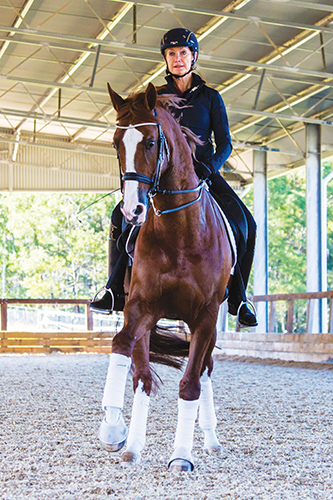
This approach gave the rider more time to execute the movement correctly without it all happening too quickly with too many counter changes. Corrections could be made and both horse and rider could concentrate better and grow in confidence.
The session finished with piaffe and passage and when Lesley was a bit scared to ask for too much and strain her precious boy, Stefan assured her, “Don’t be scared. You can’t break them in this collection. You break them in sideways and forward movements.”
By the end the horse was so much more adjustable and following Lesley Anne’s hand beautifully in a calm manner still with some energy to spare. Not bad for a horse that used to bolt!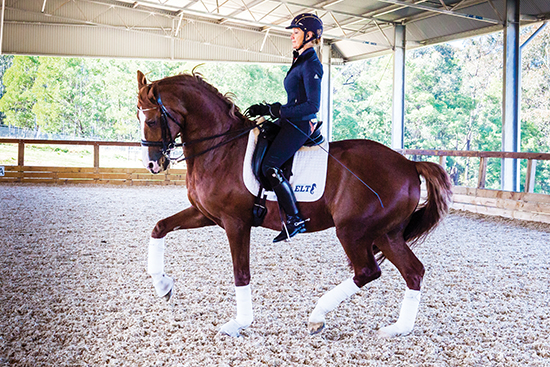
Lesley explained, “He used to be wicked. But he’s got a beautiful nature. He was just insecure from previous riders.” It just goes to show what correct and tactful training can achieve.
At the other end of the training spectrum, clinic organiser Dianne White had her young four-year-old gelding, Nureyev. Although just starting out on his career, it was the same basics that Stefan insisted on. When the young bay began to loosen up and swing his back and neck, Stefan remarked, “Good. Let him do that. Follow up with the leg and ride forward.”
Then again up came the subject of taking your time, “You have to be careful what you want. If he’s too high, don’t ask him to come so low that then you have to work him back up onto the bit. Take more time so you can be more precise. Don’t fix one problem by creating another problem. Good. Exactly. You want the horse to participate and not just hold it’s head still. You want it to be interested in the rider’s hand and address it, not avoid it.”
This in turn helped the horse’s balance and true to Stefan’s style of teaching, he explained what he wanted in more depth to make it very clear for the rider. “You want to have 50/50 hind end and neck. You need a stretch, but a little more straight forward stretch rather than really low. Forward stretch is as beneficial for the horse’s back and much easier on the balance. He can only lengthen what the back releases. It’s your co-ordination, your timing and the proper amount of hand and leg. Give along the crest. That’s right. Now just keep pushing after your hand. There. Feel that? The balance improves now.”
Stefan is very conscious of the horse’s nature and always takes that into account in the training. This decreases the pressure, especially on the young horse and makes for a more enjoyable learning environment for the animal, “Let him look a little bit. If he looks but doesn’t do anything, then why not if it helps? You want the horse to comfortably and confidently take up the space in front of your hand. You need to get him interested. You have to get him to come from behind and take up his space in front by your leg. You want that to become solid. It’s a bit fragile right now. This is the main work you have to do with a young horse. This part is so much harder to achieve than getting the horse to give in the poll. This part you cannot force. You don’t just want a pretty frame and a pretty trot, you want them swinging.”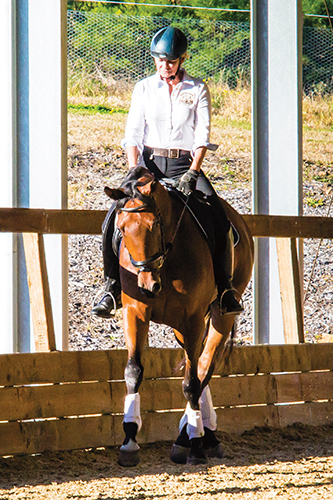
Still the young gelding was going to make Dianne work a bit and decided it would be more fun to canter. Stefan helped out, “He cantered on his own. He does this because he’s hesitant to stretch his back and just tries to go around the idea. Nice canter though! Back to trot. He’s a bit tight in the back and the stomach. Address the problem. He needs to react to the leg, be in front of the leg. Stretch your leg so it’s not primarily the spur. Yes, you need more hand but it’s how you go about it. Not by bringing the hand back but driving him into the hand. It’s the same idea as the half halt. Don’t fiddle with your hand, instead drive from your leg. Right. It’s so much better when the horse is in front of the leg.”
It was getting better all the time but the young German trainer could sense that horse and rider had just a little more to offer, “Drop your hand as he needs to get a hold of your hand. Just wait. He needs to touch your hand, not avoid it. Passive arm. You almost want to feel more weight in your rein than your arm. Right. THERE is contact. He really wants to take the rein forward. Super.”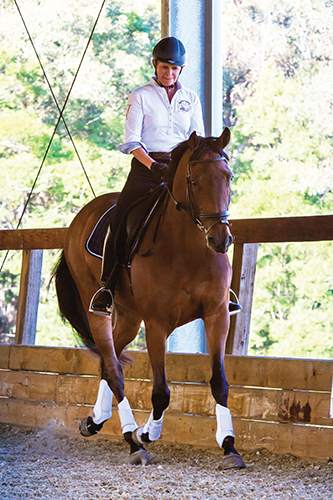
Happy, the trainer asked for canter, but one handed so that Dianne wasn’t tempted to lose what she had achieved in the contact department. He explained the priorities of training, taking one step at a time and accepting a little less than perfect to make steps forward in a positive manner. “The contact is now more secure. The horse is so light in the poll that you will never have a problem with that in your whole life, but you might have problems with the frame so although he’s out a little in front, it would be a shame to ruin what you achieved from the more secure contact just to get the nose in more.”
“The challenge is not the big step, but whether you can keep the balance, contact and frame,” and there it was again; good, old basics.
Stefan gave such focus to each rider with wonderful explanations. He took time and never got upset. Everyone came out of the arena glowing and excited for Stefan’s return. There’s nothing like a good trainer to keep you honest.
What the riders thought…
Lisa Martin attended the clinic with her ‘super mare’ First Famous. Here she gives her thoughts:
“He’s such a lovely man. About three or four years ago I took a young horse to him when he was teaching at Clemens and Judy’s (Dierks) place. I haven’t had a lesson like this before though”
“My mare is so quiet. She’s got this incredible temperament, but she’s not a naturally forward thinker. She’s actually quite laid back. We wanted to make her a little sharper, a little more responsive to the leg. Stefan said I have her going in the right direction, we just have to make sure she stays in front of the leg when you half halt and prepare for movements. Most of it is my problems! I work on my own all the time with just my mirrors.”
Photo: SWD Images
“He actually got on and rode her. He said he was a bit nervous to get on her, I think because he said there was no point in him getting on to reinvent the wheel. He didn’t want to fix anything, he just wanted to have a little feel of the piaffe and passage, to see what was under the bonnet so to speak, but then he didn’t want to get off!”
“He doesn’t get you in there and just hammer the horse. He’s a real horseman and he has incredible feel. There were all sorts of horses in the clinic, all levels and all breeds, but he had a solution for each problem with each horse.”
“Compared to a lot of European riders, because he’s been in America so long, he really knows how to talk to us. He cares. I watched him do 13 lessons in one day and shorten up his lunch to fit one more in then start up again at 08:00 the next day and he treated everyone as special as the last person. He’s so good like that. I personally don’t need to be abused, but on the other side you’re paying a lot of money and you want to be told the truth as well. He’s just full of so much knowledge.”
How long have you been coming to Australia for now?
“It might be 10 years now, I’m not sure. I know The Horse Magazine covered the clinics from very early. There is no reason not to come here. When Clemens organised it, you just put it in your diary and came back every year. We had it fade out a little while I was in America because my business picked up, and now back in Germany I have clients from Australia who have a horse with me and that’s really how it all got started again. Dianne (White) got involved and asked me if I wanted to start coming once more.”
Because you’ve been coming for so long, have you noticed changes? If so the biggest change.
“I do think the quality of the horses has improved in most cases. What I find is the riders who continuously come, you have a better start. There are the basics there that you do not have to explain again. How to straighten the horse or do shoulder in, they know what’s going on. Obviously there are always things to improve but it just seems that the ones who continuously come, it’s just a much easier start.”
Contact seems to be a big theme with you from what
I’ve seen.
“The quality of the contact indicates and shows up any apparent, or non apparent problems. Contact is really the ultimate indication of how good or bad a horse is performing. In the contact you can see suppleness issues, you can see straightness issues, see if a horse is happy to collect, or if in every half halt he is coming against the bit or pulling back. Every issue is readable in the contact.”
You said in one lesson that you have to train in terms of the horse’s nature. Can you expand on that?
“There are a few things that we should just know about the horse’s nature. We don’t need to be experts but a few basic things; knowing your horse is a flight animal, part of it is that if you have a spooky horse, it doesn’t hurt to have a bit of knowledge about the horse in terms of the spookiness. Look at a horse and how it reacts in nature. If there is something new approaching it, most people think the horse just runs right away which isn’t true. The horse sees something, it first looks and has its moment of curiosity and then it determines which way to go. Either it goes toward it very carefully and tries to work it out or decides it’s scary and runs off. Especially with young horses, you need to go the correct way and not ride the horse right into the spooky thing and force it and expect 100% obedience. Pass the object with flexion to the inside so the horse knows it doesn’t have to sit on the problem but it just has to pass. Things like that can make a huge difference in the lifetime of a horse and how it will manage difficult situations.”
“Like in a half halt, there is a reason that you give. Not only a physical one, but a psychological one. Being a flight animal, they don’t like to be cast and held. So yes when you give, it improves the balance anyway. You can keep the horse in an artificial balance by just holding the rein but that is no one’s desire. And when you give in the right moment of the half halt, actually when the horse offers to come back, the horse is much happier and it’s more natural for him to keep coming back rather than him feeling like he’s being held back. Already physiologically it will stride out again. Ride a horse more, it strides out more.”
You gave a lecture a few nights back. You did that the last time as well?
“It was kind of a pilot project. We didn’t know what to expect or if people would like it. They came back so apparently it must not have been too bad!”
Your subject was throughness?
“Yes it was. It’s always more or less on throughness when you go to riding theory. This time I tried to go to maybe less apparent throughness problems in certain movements in the dressage test. It’s easy to make out apparent problems when things go awfully wrong. It is more to work out how supple a horse is because a judge or rider has to not only determine between good and bad, but also between what is good, what is quite good, and what is sufficient. A lot of times riders and trainers get stuck with a certain problem. You want more activity in the higher collection and you don’t get it and the horse just stays behind the leg. You could crack the whip and get it for a few strides, but you always usually end up with the same problem, unless obviously you create fear. Or you find exactly why the horse has a hard time responding willingly to the leg. It could be a tight back, for instance. So I was more going into these subtle areas where you try to find reasons for apparent problems we see a lot of times, like the reasons for rhythm faults, is elsewhere. If the horse gives me all the time a rhythm fault in the medium trot, what could be the reason? Rather than try it five times and get a rhythm fault five times, you can determine if it is a loss of self carriage, a loss of balance, therefore I tried to give some ideas on how to improve self carriage and balance and then see if it works better in the next medium.”
“Now that’s not my idea, it is the idea of the German riding system, the training scale, not to just know the blocks of the training scale, everyone knows that, but to actually see the relations and backgrounds. Problem with rhythm, we go to a collection reason. So that was really mostly the subject of the lecture.”
“Last time I did that more with the biomechanical background and this time I tried to apply it more to the quality of the execution of different movements like half pass, medium trot, canter pirouette, piaffe, passage, things like that. But even also problems in the collected walk.”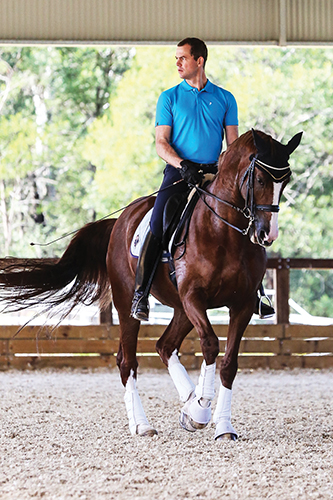
Photo: SWD Images
So you’re back in Germany now. What’s daily life like?
“I run a training business. The aim is that we have high quality horses that have time. I’m lucky I have only clients that give me enough time to build up the horses carefully.”
You kept saying that in the lessons today too so it must be important to you?
“It is. If you want the horse to naturally work and willingly work, it has to develop the mental strength and the physical strength and also the correct technique to perform high collection, for instance, because high collection isn’t just a matter of strength, which you hear a lot of times, and obedience. Most of it is that the horses have to learn technically how to put their bodies together so that it’s easy for them to perform; that they can balance. A lot of horses are out of balance and cannot perform correctly.”
“Obviously the objective is to compete these horses when they are ready and bring them on and see where we can get to.”
Do you prefer the horse training or teaching?
“I do prefer to ride myself in all honesty. At the same time, if it’s not becoming an overwhelming factor in my business, the teaching is fun. I like to interact with people and I also do part of the squad training in Germany for the young riders in Westphalia. This is a shared programme where the young riders weekly go to appointed regional coaches, so I do that and I do a few private trailer-in lessons, but most of my main business is the horses I train at my facility. I train them mostly myself. There is me and two staff, one apprentice and one bereiter, which is good for a smaller number of horses. We have ten.”
You trained with Klaus Balkenhol?
“I spent a small part of my apprenticeship there, but not a large part. It was more after I finished law school I went back to him and that’s the biggest amount of time I spent there and also I went back after I did my masters.”
I would have thought he was a pretty influential person in your career?
“I lot of people say that, but yeah, I say that also.”
Who or what else?
“Law. Which was really my idea.”
But not a good one, by the way you said that?
“No it was an excellent idea. I recommend it to everyone who wants to ride professionally to extend their horizons.”
Why?
“Well obviously when you know how law works, it does help you in certain decisions, it helps you to judge certain situations. More the business part so when you run your own business, it never hurts to know a little bit more than others and also to be aware of everything. Things like liabilities, which is a big subject in our sport. I think it also helps you to be a reasonable person and know other people’s problems. You do think in very structured ways. It certainly helps to solve problems, in the riding as well. If you have a structure, you don’t just think that you have to push the horse somehow into certain movements, but you know how it develops. At least it helps me and I do think a lot of horses benefit from it.”
So you have a more open mind than just horses. Do you do anything else?
“I don’t have a strong hobby or anything. Now my wife is not riding which is nice because we meet a lot of other people and talk about other subjects and you’re not getting too tangled up and lost in certain problem atmospheres and sometimes it’s good, we all know, to get your head out of the horse scene and come back in and it makes it a lot easier to solve problems.
So coming back to your horse-related influences, does anyone stand out or do you watch and experiment and sort things out for yourself?
“I watch every rider when I have the time, and I think every single rider has at least one strength and I make it a little bit my habit to find that. If you look at a show, even at lower level riders who are not that well known, and you can see their strength, it makes you reflect back on your own riding and helps it.”
“In my time in America I trained with Guenter Seidel who I want to say was very influential, especially in terms of stress management at shows and in terms of confidence which is also a big part of dressage. Having strength in your self confidence in stressful situations. That is next to the riding because obviously he was a fantastic coach.”
“Then you know I was at the Westphalia Riding School as the deputy director for a few years after I came back to Germany. That’s actually why I haven’t been in the show ring for a while. I backed off from competing. I left a number of good horses in America and I had to build my business up again pretty much. Right now I’m hoping I’m on the verge of getting out once again, but the very positive thing at the School was that you had to deal with eventing and you had to deal with jumping and also that biomechanically understanding the dressage side of it, it did help to see horses from a different standpoint, allowing the horse more motion and not letting things get too rigid, that did help a lot.”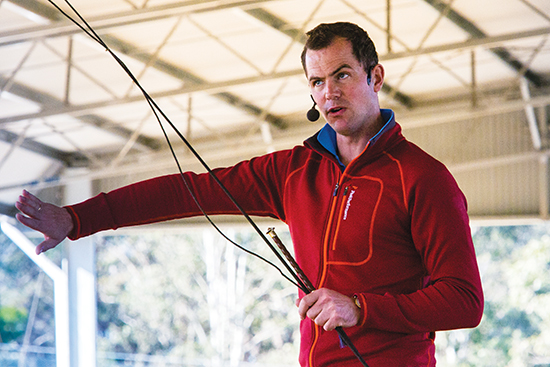
From Guenter Seidel’s influence, have you done much sports psychology work?
“I haven’t. I have a little bit of theoretical knowledge about it. I am luckily not the most nervous person at shows so I didn’t have a primary reason to worry about it, but at the same time, just the way he teaches, the way he deals with problems, he’s pushing you but at the same time never pushing you past a certain point. I mean you can push and get after a rider and really give him a hard time with his confidence. You see that all the time. Maybe the picture works, but the rider is not confident in what he is doing. Guenter has a way of teaching and training, of pushing you, but at the same time helping your confidence, not diminishing it. But that is also, as you say an approach to life as well, how to deal with difficult situations or stress. So that was just one of the fantastic experiences from working with him.”
So you don’t sit and meditate all day?
“I don’t! haha.”
What is your view on rider fitness?
“I will probably give you the same answer as most. I probably could do more. When you are a professional, you ride a lot of horses so in general you are quite fit. But a rider has to assess his own weaknesses, like elasticity, suppleness, things like that. I don’t think it’s about the general fitness. That would be for an amateur or when you get to a certain age then I imagine it would help. My age and my job means that I am pretty fit, but you would look more at seat problems and training that would improve that. We have a lot of possibilities to improve certain areas of your body which I have to admit I haven’t done enough about.”
How do you view the state of dressage at the moment?
“I think the success of the British is just fantastic for the sport in my opinion. It is a good development because first of all, it kind of tells that with the classical system you can have that success which in my opinion is fantastic. Secondly just the fact that another nation is suddenly up there is always good for competition in general even though obviously I’d like my nation to be in front! But for the sport, if you see it neutral, it’s always good for the competition and the future of dressage and for the Olympics.”



